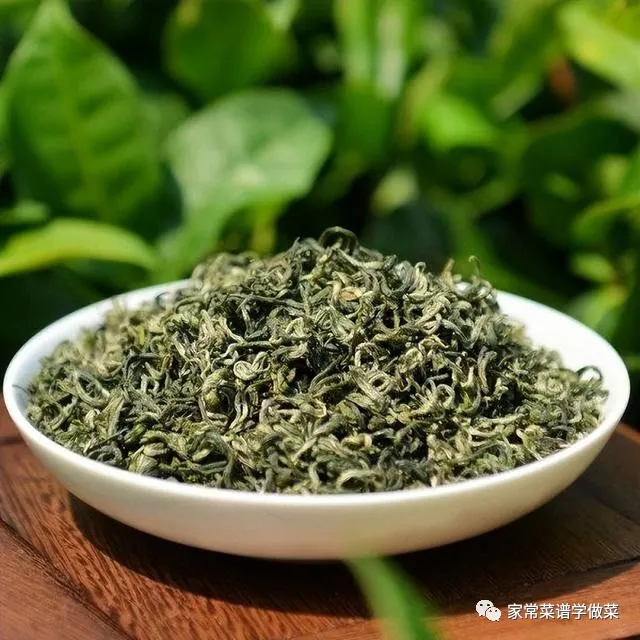Green tea refers to unfermented tea leaves that retain their natural substances through processes such as pan-firing, rolling, and drying, resulting in a green color. There are many varieties of green tea, including Longjing, Biluochun, and Huangshan Maofeng, each with its unique characteristics. The features of green tea are mainly reflected in the following aspects: 1. Color: The dry green tea has a lush green color, with a clear and bright infusion, and a tender green leaf base, giving a fresh and natural feeling.
2. Aroma: Green tea has a delicate and pleasant aroma, rich in plant fragrance. Different varieties of green tea have distinct aromas; for example, Longjing tea has a bean-like scent, while Biluochun has a floral aroma. 3. Taste: Green tea has a fresh and sweet aftertaste with a rich flavor. A sip of green tea feels like being in nature, refreshing and uplifting. Which of the four best green teas in China have you tasted? They are known for their tenderness, clarity, freshness, and sweet taste.I. West Lake Longjing West Lake Longjing enjoys a high reputation in the Chinese tea industry and is one of the top ten green teas in China. Its name has become synonymous with high-quality green tea. The tea is produced in the West Lake District of Hangzhou, Zhejiang, including areas such as Shifeng, Longjing, Wuyun Mountain, Huqiao, and Meijiawu. The unique geographical environment and suitable climate of these places provide excellent conditions for the growth of West Lake Longjing.
The quality of West Lake Longjing can be described as ‘green in color, rich in aroma, mellow in taste, and beautiful in shape’. Its lush green color resembles the new leaves of spring, offering a fresh and natural sensation. Its rich aroma is noticeable with just a splash of water, providing a refreshing and uplifting experience. Its taste is mellow, with a sweet aftertaste that leaves a lasting impression. The shape of West Lake Longjing is flat and straight, with a color similar to brown rice, slightly yellow, due to its tender and blooming leaf base. This unique shape and color make West Lake Longjing stand out among many green teas and become the king of green tea in people’s hearts. II. Dongting Biluochun Dongting Biluochun’s name is as poetic as a Jiangnan ink painting. It is produced in Dongting Mountain, Wu County, Taihu Lake, Jiangsu, and is one of the members of Dongting Mountain and one of the top ten famous teas in China. Its creation is like a messenger of spring, bringing the freshness of Taihu Lake and the beauty of Dongting Mountain into thousands of households. It was listed as a tribute in the Tang Dynasty and was also known by ancient people as ‘gongfu tea’ and ‘new blood tea’. The tea is made from tender buds picked in spring and fried using a unique process, which makes the tea show white hairs, with a silver-green color, and an enticing emerald green appearance. Dongting Biluochun is famous both domestically and internationally for its beautiful shape, bright color, rich aroma, and mellow taste.Savor a sip of Dongting Biluochun, and you will feel as if you are in the water towns of Jiangnan. The tea soup is clear and bright, like the rippling waves of Lake Tai; its aroma is rich, like the overflowing fragrance of flowers from Dongting Mountain; and its taste is fresh and mellow, like the fullness of spring fruits.
Lu’an Guapian is a unique tea in Chinese tea culture, beloved by countless tea enthusiasts for its distinctive shape and taste. It is not only a historical famous tea of China but also one of the top ten famous teas in the country. In the Tang Dynasty, it was called ‘Luzhou Lu’an Tea,’ a name steeped in history. By the Ming Dynasty, it was praised as ‘Lu’an Guapian,’ becoming a symbol of superior and top-grade tea. The unique shape of Lu’an Guapian resembles a melon seed, naturally flat, with a slightly curled edge, a treasure-green color, uniform size, and no buds or stems. This distinctive shape sets Lu’an Guapian apart among teas. During the Qing Dynasty, it was designated as a tribute tea for the imperial court, highlighting its high status in the world of tea. When you taste Lu’an Guapian, you will find its fragrance fresh and invigorating, its taste fresh and mellow with a sweet aftertaste, its soup clear and transparent, and its leaves green and bright. Xinyang Maojian has won the hearts of countless tea enthusiasts with its unique quality and taste. This tea is produced on the peaks of mountains such as Cheyun, Jiyun, Tianyun, Yunwu, Zhenleishan, Heilongtan, and Bailongtan in Xinyang, Henan. The finished Xinyang Maojian has a fine, round, and straight shape, with a green color and visible white hairs, which are its unique visual characteristics. The production process of this tea is very particular, requiring multiple steps such as picking, withering, frying, rolling, and drying. The soup color of Xinyang Maojian is clear and green, with a fresh and high aroma, and a fresh and mellow taste, which are its unique intrinsic qualities. When drinking, you can feel its overflowing fragrance, fresh taste, and long aftertaste. The leaf base of Xinyang Maojian is strong and evenly green, which is its unique quality assurance. The leaf base of this tea shows a tender green color, full buds, and uniform leaves, which are important signs of the high quality of Xinyang Maojian.


